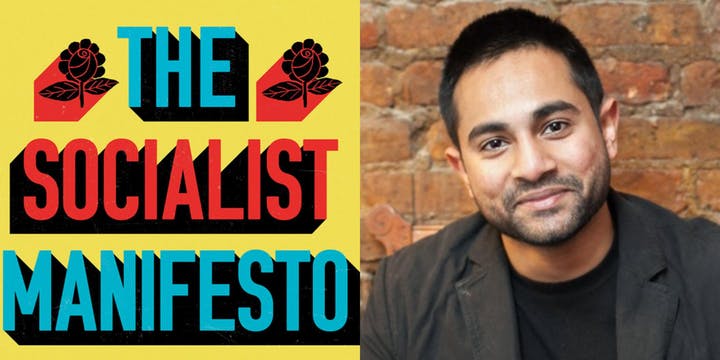Published by: Verso Books, 2019
In this year’s State of the Union address, Donald Trump stated that “America will never be a socialist country.” More recently, he declared that he will be running in 2020 to fight a “socialist takeover.” Why, all of a sudden, do we have this anti-socialist rhetoric? Because socialist ideas are making a comeback! A recent Gallup poll found that 58% of Americans aged 18 to 34 think socialism is good for the country. This is reflected in the popularity of Jacobin magazine and particularly its website, with more than a million-and-a-half views a month. The publication by Jacobin Editor Bhaskar Sunkara of The Socialist Manifesto is, therefore, very timely. Kevin Henry reviews the manifesto, which provides much food for thought on how the ideas of socialism can win in the “era of extreme inequality.” [originally published in Socialist Alternative- magazine of Socialist Party]
The opening chapter of The Socialist Manifesto by Bhaskar Sunkara provides the reader with an outline of how, over a twenty-year period, a New Jersey factory worker could see their lot improve when a “left-populist movement” wins the Presidency and a majority in Congress to introduce social-democratic reforms, backed by “rank and file resistance in the labour movement.” Ten years later, a “socialist coalition has a mandate to change society” and sees businesses nationalised, with capitalists “simply resigned” to these measures. In many ways, this thought-process, more than any other part of the book, summarises the outlook of the author and of all those who organise to transition from capitalism to “democratic socialism” through reforms over a protracted period. Essentially he’s articulating the classic position of reformism, that the capitalist system can be reformed out of existence.
Despite the title, most of the book is focused on providing a history of the socialist movement and only really, in the final part of the book, do we get a “road map based on the long, complex, variously inspiring and dismal history of left politics” in the form of 15 programmatic points. If this book helps to introduce a new generation to the history of the socialist movement, including its much forgotten history in the USA, then it will serve a useful purpose. A more detailed review could explore the inaccuracies in this survey of the socialist movement, but this review will focus on some of the points of difference with the revolutionary approach, which are useful for socialists to debate today.
Bolshevism or Stalinism
Sunkara does at times present ideas which are old wine in new bottles but, to his credit, he doesn’t simply repeat the more outlandish distortions that are so often levelled at revolutionary socialists. For example, he rejects the idea that the 1917 Russian Revolution was some sort of coup, describing it as a “genuine popular revolution led by industrial workers, allied with elements of the peasantry.” For Marxists, this was a seminal event in history, where working-class people, in an active and organised mass uprising, took power into their own hands via workers’ councils (soviets).
After the February Revolution which abolished Tsarist despotism, there were 300 soviets in Russia which, in reality, controlled virtually every aspect of society. By October, this number grew to 1,200. Delegations elected by workers in factories or districts would come together to discuss how to defend and take the revolution forward. This was at a time when most workers in the so-called “democratic countries” were still denied the right to vote at all. In Russia, workers had engaged in an incredible level of self-organisation and began to pose the question of taking state power for themselves, in the interests of the overwhelming majority. Within this, the Bolsheviks, who led the call for “all power to the soviets”, grew from a small minority in February to a majority in the soviets by October. The government that came to power on the basis of the October Revolution, carried through the abolition of capitalist property relations, along with enacting social reforms that, a century later, remain radical compared with much of the world today.
Sankara does, albeit with his own twist, echo the tired old trope that actions taken later, in civil war conditions, allowed authoritarianism to develop and that the Bolsheviks had not sufficiently planned for what to do after the revolution. However, it is superficial and wrong to suggest that the rise of Stalinism was a product of measures the young workers’ government was forced to take in wartime conditions. It was a result of a more complex mixture of famine; backward economic and cultural conditions; the perishing of a broad layer of the advanced workers in the civil war; and primarily isolation — due to the defeat of other revolutions abroad.
Sunkara tells us that “the international revolution didn’t come.” This is a one-sided and ultimately distorted presentation. The devastating effects of the war and the inspiring example of the Russian Revolution led to a revolutionary wave across Europe and the world, most importantly in Germany, where the working class heroically fought for power, including forming soviets in various forms. The “international revolution” did come, it just didn’t succeed. What was missing was not the willingness or capacity of the working class to fight for power, but leadership, like that provided by the Bolsheviks in Russia – capable of forging a road to power.
What Sunkara underestimates is that revolutionary movements – from in Spain in 1936 to France in 1968 or Sudan in 2019 – will happen whether socialists are there are not. The lesson from history that the issue is whether there will be a revolutionary leadership, in the form of a revolutionary party, there capable of carrying through the fight for power.
Reformism’s history
Sunkara’s position ultimately points in a very different direction. For him, “a few hundred miles to the west of Moscow, democratic socialism came close to becoming a reality” – by which he means social democracy in Sweden. In the chapter, “The God That Failed”, named after a famous anti-communist book from the 1940s, we get a potted history of social-democratic governments coming to power in the inter-war period, with a particular focus on Sweden.
The social-democratic governments in Sweden delivered important reforms, particularly in the 1960s and 70s when the then-prime minister, Olof Palme, was pressured by a strong workers’ movement and radicalisation among young people which threatened to break the relative social peace. An illustration of how things changed for workers in this period can be seen in the position of women. In 1966, 66% of women stayed at home. By 1974, the year abortion rights were won, 80% of women were part of the workforce – the highest level in the world. A central reason for this was the role played by a strong labour movement, which acted to pressure the government and resulted in childcare being part of the public sector, with the number of nursery places rising from 72,000 in 1975 to 330,000 ten years later.
The Social Democratic Party programme talked about placing “decision-right over production in the hands of the entire people” and the ‘Meidner Plan’ was developed by the trade unions, requiring all companies above a certain size to issue new stock shares to workers so that, within 20 years, the workers would control 52% of the companies they worked in. Crucially, however, capitalist rule was never seriously challenged.
Up until 1976, only 5% of Swedish industry was in public hands and, even after decades of social-democratic governments, “fifteen families” owned the majority of Swedish industry. As Sunkara points out, “No matter how creatively implemented, it was still dependant on private sector profits and the calculation by business that maintaining the peace with a powerful labour movement was worth the cost.” On the basis of post-war growth, capitalism had the space to accept such reforms. This was reflected in the idea that, “What was good for Volvo also seemed good for Sweden”. They also genuinely feared not just a powerful workers’ movement, but the fact that only a few hundred miles away existed an alternative social system based on state ownership and planning of the economy – albeit in Stalinist form.
End of the post-war boom
The fact that “social democracy was always predicated on economic expansion” meant that, when the post-war boom came to an end, capitalism had less room to grant new reforms or maintain old ones, and neo-liberal counter-reforms were necessary from the point of view of the capitalists in order to restore their profits. This was compounded by important industrial defeats, and later with the ideological pro-capitalist offensive that followed the collapse of Stalinism.
The lack of space for such reform was seen in the election of President Mitterand in France. He was elected on a radical Keynesian programme, known as the “110 propsitions for France.” They included public works programmes and a 1982 nationalisation bill which put five industrial groups, forty banks, two steel companies and the armaments industry into public ownership in order to maintain employment. The response of international and domestic capitalism was a $5 billion flight of capital, forcing the government into a u-turn which included implementing austerity policies.
For Marxists the lesson here is clear, as Sunkara points out: leaving capitalism unchallenged and key sectors of the economy in private hands ultimately leads to the destruction of those reforms won. The same is true today in relation to Venezuela which, strikingly, the book does not deal with. For a period, the Venezuelan government was able to improve the position of workers and the poor on the basis of using the country’s oil wealth. However, by leaving the rest of the economy in private hands, the Venezuelan government has allowed the local capitalist elite and US imperialism to sabotage the economy.
Sunkara draws much more pessimistic conclusions about what he very broadly sees as attempts at socialism in the ‘third world’. He repeats the old stagist idea that countries have to go through a capitalist stage of development before they can begin to transition to socialism, believing that the “best we can hope for in the developing world” is “encouraging capitalist growth, while mitigating its worst effects and redistributing it spoils – as the Workers’ Party in Brazil and other Latin American pink tide governments have recently done.” Again, we are given an assessment of how this has worked out, but the election of the ultra-reactionary Bolsonaro government in Brazil, assisted by mass disillusionment in the Workers’ Party, shows the obvious limitations of this approach. Like the Communist Parties of the past, Sunkara’s embracement of this stages theory is rooted in a lack of confidence in the working class.
Unanswered questions
What is also striking is the failure to discuss and analyse the recent experience of the left in this era of “extreme inequality,” particularly the experience in Greece. Sunkara poses the question: “How do we make sure that any left government can actually stick around long enough to win some victories (and not just retreat like Greece’s Syriza did)?” However, this question isn’t answered, except to say that mass pressure is necessary so that “leaders ensure confrontation over accommodation with the elite.”
Similarly, Sunkara recognises that the capitalists will “do everything to stop us” and points to them engaging in capital strikes – withholding of investment and siphoning off cash. But there are no answers as to how, for example, a left government could respond to flights of capital. A starting point would be to look at what those on the left argued was necessary in Greece to avoid the capitulation of Syriza. For example, this is the programme that was developed in some detail by Xekinima (sister organisation of the Socialist Party in Greece):
“Impose capital controls; refuse to pay the debt; nationalise the banks; move speedily towards a national currency (drachma); use the liquidity provided by that currency to finance major public works, to stop the continuous contraction of the economy and put it back on the path of growth; cancel the debts of small businesses crushed by the crisis and provide loans under favourable conditions so they can get back into activity and provide a quick spur to the economy.
“Nationalise the commanding heights of the economy; plan the economy, including a state monopoly of foreign trade, so that it acquires sustained growth and does not serve the profits of a handful of ship-owners, industrialists and bankers, but is in the service of the 99%.
Create special planning committees in every sector of industry and mining, and put particular attention on agriculture and tourism which are key to the economy and have huge potential. Establish democracy in the functioning of the economy, through workers’ control and management in every field and level.
Appeal to the workers of the rest of Europe for support and solidarity, calling on them to launch a common struggle against the EU of the bosses and the multinationals. For a voluntary, democratic, socialist union of the peoples of Europe.”
The parliamentary road?
In short, what was needed in Greece was “an anti-capitalist, anti-EU offensive on a socialist programme.” Such a “rupture” requires the mass mobilisation of the working class. For Marxists, the working class is central; it is not simply a voting bloc or a force to put pressure on a left government as an auxiliary tactic. The central task is for the working class to take ownership of the economy into their own hands, creating their own radical democratic institutions, and run society in their interests. For Sunkara, the central task is as follows:
“Democratic socialists must secure decisive majorities in legislatures while winning hegemony in the unions. Then our organizations must be willing to flex our social power in the form of mass mobilizations and political strikes to counter the structural power of capital and ensure that our leaders choose confrontation over accommodation with elites. This is the sole way we’ll not only make our reforms durable but break with capitalism entirely and bring about a world that values people over profit.”
As historian Paul le Blanc noted in his review of The Socialist Manifesto, despite the positive reference to the German revolutionary Rosa Luxemburg, the author reflects more the reformist ideas Luxemburg struggled against. In comparing the approach of the Bolsheviks to German social democrats, she commented:
“German Social-Democrats have sought to apply to revolutions the home-made wisdom of the parliamentary nursery: in order to carry anything, you must first have a majority. The same, they say, applies to a revolution: first let’s become a ‘majority.’ The true dialectic of revolutions, however, stands this wisdom of parliamentary moles on its head: not through a majority, but through revolutionary tactics to a majority – that’s the way the road runs.”
In the chapter “Future We Lost”, much is said about the history of the socialist movement in Germany, but the lessons are not fully brought out. We are told that leaders like Karl Kautsky, at the time considered the “pope of Marxism,” had no choice but to accept the German ruling class’s war mobilisation. However, this ignores the reality that workers in the early days of the First World War were prepared to take action against imperialist slaughter, reflected in numerous mass anti-war demonstrations, but were betrayed by the mass workers’ parties.
Karl Kautsky was one of the leaders Luxemburg clashed with. Sunkara’s sympathy with this thinker is clear when he argues that Kautsky “believed workers would win power through free elections, [then] extend political and civil liberties and radically reform, not smash, the existing state.” This notion that it is possible simply to reform the capitalist state, with its entrenched bureaucracies and armed forces, is also reflected in one of the fifteen points where the focus is to “democratise our political institutions.” Socialists, of course, fight for and support every reform, including democratic reforms, under capitalism. However, it is a very different thing to believe that these (capitalist) “institutions”, in themselves, represent the route to power for the working class.
Marxists and the state
It is noticeable that while the parliamentary road to socialism is alluded to, the concrete experience of the Allende government in Chile, the most famous example of this approach, only gets a tiny mention. The 1970 election of left-wing president, Salvador Allende, was part of a revolutionary process that saw the US-owned copper mines nationalised, along with important sectors of the banks. Plans were announced for the nationalisation of nearly 100 companies. By 1973, over 40% of the economy was in public ownership. Yet the state itself, including the army, was left untouched. On 11 September 1973, a military coup backed by the CIA was launched that crushed the Allende government, bringing to power a brutal military dictatorship that murdered 30,000 people.
History is littered with examples that illustrate that the capitalist state is not neutral but, in the words of Friedrich Engels, in the final analysis, could be reduced to “armed bodies of men acting in defence of property”. Sunkara does touch on the Marxist view of the state, even giving the example of how the Trump presidency has come into conflict with sections of the capitalist state, nervous about how his right-populist policies are a challenge to NATO. But the full implication of what this means from the point of view of the strategy of socialists is not brought out.
How do we win?
For Sunkara, the working class are key in order to put pressure on a left-wing government or win concessions from a capitalist government as “capitalists depend on their labor for profits, and when organised, workers can withhold that labor to win reforms.” He correctly observes that, while the working class has changed, it has changed “not as much as you think,” in that working-class people still hold that power.
He correctly believes that “socialists must embed themselves in working-class struggles” and observes the very important role played by a “militant minority”, including socialists, in the inspiring West Virginia teachers’ strikes and that for socialists, “it is not enough to work with unions for progressive change. We must wage democratic battles within them.” He is also correct to argue that “a loose network of leftists and rank-and-file workers isn’t enough. We need a political party” and that such a party should base itself on the “disruptive capacity of labor.”
Where Marxists differ with Sunkara is that, for us, it is not simply a question of the working class having massive power that can win reforms or have a “disruptive capacity” but, as the title of his chapter on Marx and Engels puts it, the working class are the “gravediggers” of capitalism and the socialist transformation of society requires the working class taking control of society. And, crucially, the party that we need is one that puts this revolutionary strategy at the centre of its political programme.
This book has been compared in many reviews to the Communist Manifesto, written 171 years ago, but apart from superficial comparisons, with the titles and the young ages of the authors, the comparison doesn’t go very far. However, the ideas in the book are worth discussing and debating out in order that we can build a socialist movement actually capable of transforming society.












